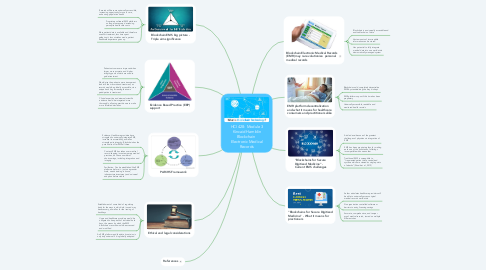HCI 428: Module 3 Kincaid Hamblin Blockchain Electronic Medical Records
by Kincaid Hamblin

1. Blockchain Electronic Medical Records (EMR) may re-revolutionize personal medical records
1.1. Blockchain is a universally accessible and audit-able chain of data
1.2. Vast amounts of incorruptible information can be stored
1.3. Has potential to fully integrate medical data into one world wide democratically managed system
2. EMR platform decentralization and what it means for healthcare consumers and practitioners alike
2.1. Blockchain could completely decentralize EMR by standardizing the way it is kept
2.2. EMR platforms up until this time has been proprietary
2.3. Universally accessible, readable and monitored health records
3. "Blockchains for Secure Digitized Medicine" - Current EMS challenges
3.1. Article describes one of the greatest challenges of physicians is integration of EMS
3.2. EMS has been proprietary thus far, making each one of the hundreds of offerings incompatible with one another
3.3. Traditional EMS is susceptible to "fragmented patient data, centralized systems which are viewed as single points of attacks" (Shuaib et al., 2019)
4. "Blockchains for Secure Digitized Medicine" - What it means for practioners
4.1. Author articulates healthcare providers will be able to universally access original medical records world wide
4.2. No organization controlled software or barriers to entry, licensing savings
4.3. Accurate, comprehensive, and tamper proof medical records, stored on multiple different sites
5. Blockchain EMS big picture - Triple aim significance
5.1. Records will become universally accessible, increasing opportunity for use in care, enhancing population health
5.2. Proprietary software/EMS platforms no longer necessary, decreasing per-capita health care costs
5.3. More patient data is available and therefore used for treatment, less time spent gathering it, less mistakes made, patient healthcare experience goes up
6. Evidence Based Practice (EBP) support
6.1. Patient outcomes are improved when larger, more accurate, and higher integrity pools of data are used to guide treatment
6.2. Would give the patient a more transparent look into their records and treatment, as records would be globally accessible, via a unique hash key, increasing their own participation in treatment
6.3. Clinical expertise and external scientific evidence would be integrated more thoroughly, allowing practitioners to make more informed decisions
7. PARiHS Framework
7.1. Evidence: Healthcare providers have struggled to universally integrate EMS, increase its accessibility, as well as strengthen its integrity - Blockchain has the potential to offer EMS all three.
7.2. Context: EMS has taken over medical record keeping in contemporary medical practices, but has a number of shortcomings, including integration and integrity
7.3. Facilitation: Can be established like EMS platforms before it - just on a grander scale, needs training in its use, infrastructure investment, and universal adoption before viable
8. Ethical and legal considerations
8.1. Establishment of some kind of regulatory body for the ways in which info is used may be necessary, as well as for the issuing of hash keys
8.2. Users and healthcare providers would be obligated to keep track of individual hash keys, the means by which the EMS blockchain's records would be accessed and modified
8.3. An EMS platform and the data it contains is only truly universal if it is globally adopted
9. References


